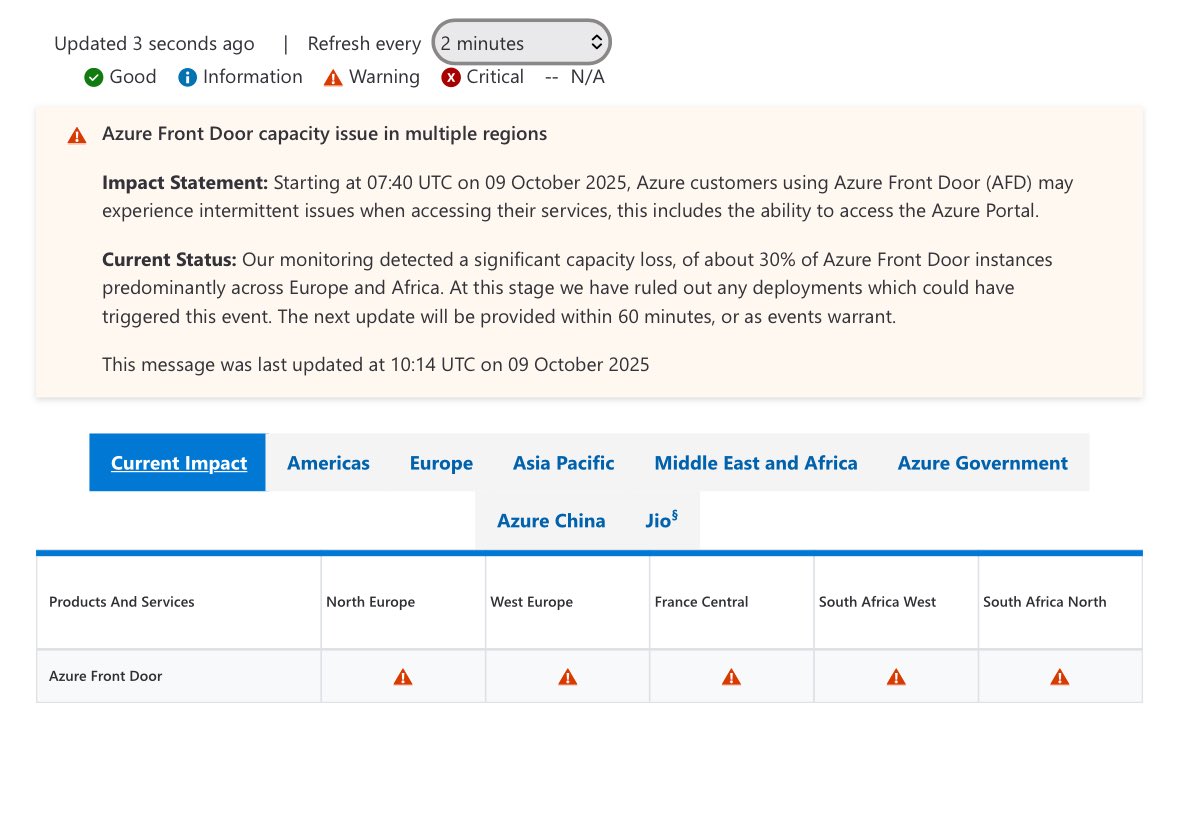Table of Contents
TLDR
Microsoft Azure experienced a significant global outage affecting businesses worldwide. The Microsoft Azure outage disrupted critical cloud services. Azure’s Kubernetes Service (AKS) suffered major failures. Users reported widespread connectivity problems. The incident highlights cloud infrastructure vulnerabilities. Organisations need robust disaster recovery plans. Penetration testing services help identify such risks.

Azure Global Outage Cripples Business Operations
Microsoft Azure suffered a major worldwide service disruption on 9 October 2025. The Microsoft Azure outage affected numerous enterprises globally. Cloud-dependent businesses faced immediate operational challenges. Azure’s infrastructure experienced unprecedented failures.
The outage began during peak business hours. Companies lost access to essential cloud applications. Many organisations reported complete service unavailability. Customer-facing systems went offline without warning.
Technical Causes Behind Microsoft Cloud Services Down
Azure Kubernetes Service (AKS) failures triggered the widespread disruption. Kubernetes orchestration systems stopped functioning correctly. Container deployments failed across multiple regions. Engineers struggled to restore normal operations.
The Microsoft cloud services down incident revealed infrastructure weaknesses. Load balancing systems couldn’t redirect traffic properly. Failover mechanisms didn’t activate as designed. Database connectivity dropped across primary data centres.
William Fieldhouse, Director of Aardwolf Security Ltd, explains: “Cloud providers must implement rigorous testing protocols. Network penetration testing services identify vulnerabilities before outages occur. Organisations cannot rely solely on provider assurances.”
Impact Assessment of the Azure Global Outage
Financial services bore significant losses during downtime. E-commerce platforms couldn’t process customer transactions. Healthcare systems struggled with patient data access. Manufacturing operations halted due to IoT disruptions.
The outage affected Azure services across continents. European businesses reported morning disruptions. Asian markets faced afternoon service failures. American companies experienced evening connectivity problems.
Recovery Timeline and Microsoft’s Response
Microsoft engineers worked urgently to restore services. Initial recovery efforts focused on critical systems. Core services returned within several hours. Full restoration took considerably longer.
The company issued regular status updates. Microsoft acknowledged the severity promptly. Technical teams deployed emergency patches. Service monitoring increased across all regions.
Lessons for Cloud Security Professionals
The Microsoft Azure outage demonstrates cloud dependency risks. Single-provider strategies create vulnerability points. Multi-cloud architectures offer better resilience. Disaster recovery planning requires constant evaluation.
Security professionals must assess infrastructure regularly. Top pen testing companies provide comprehensive vulnerability assessments. Regular testing prevents catastrophic failures. Organisations need proactive security measures.
Businesses should maintain local backup systems. Cloud services cannot guarantee 100% uptime. Redundancy planning protects against provider failures. Companies need alternative operational procedures ready.
Preventing Future Cloud Service Disruptions
Organisations require robust continuity strategies. Regular security audits identify potential weaknesses. Load testing reveals infrastructure limitations. Stress testing confirms system resilience.
Professional security testing strengthens cloud deployments. Vulnerability scanning detects configuration errors. Penetration testing validates security controls. Companies should request a penetration test quote regularly.
Monitoring systems need continuous improvement. Automated alerts detect anomalies quickly. Incident response procedures require regular updates. Teams must practise recovery protocols frequently.
Frequently Asked Questions About the Microsoft Azure Outage
What Caused the Microsoft Azure Outage?
Azure Kubernetes Service failures triggered the disruption. Container orchestration systems experienced critical malfunctions. Infrastructure weaknesses prevented proper failover activation. Microsoft continues investigating root causes thoroughly.
How Long Did the Azure Global Outage Last?
Core services recovered within several hours initially. Complete restoration took much longer periods. Different regions experienced varying recovery times. Some services remained partially affected overnight.
Which Services Were Affected by Microsoft Cloud Services Down?
Azure Kubernetes Service suffered primary failures. Virtual machines experienced connectivity problems. Database services showed intermittent availability. Storage systems reported access difficulties. Web applications faced significant disruptions.
How Can Businesses Protect Against Cloud Outages?
Implement multi-cloud redundancy strategies immediately. Maintain local backup systems always. Regular penetration testing identifies vulnerabilities early. Disaster recovery plans need frequent testing. Professional security assessments strengthen infrastructure resilience.
Should Companies Continue Using Azure After This Outage?
Azure remains a robust cloud platform. All providers experience occasional disruptions. Companies should evaluate their risk tolerance. Multi-provider strategies reduce dependency risks. Regular security audits ensure proper configurations.
What Steps Should IT Teams Take Now?
Review disaster recovery procedures immediately. Test backup systems thoroughly. Conduct vulnerability assessments regularly. Update incident response protocols. Consider engaging professional security consultants.
Discover more from Aardwolf Security
Subscribe to get the latest posts sent to your email.